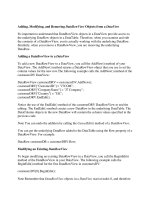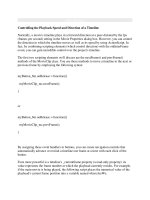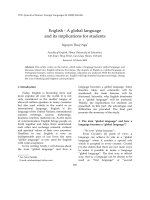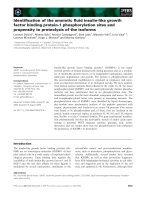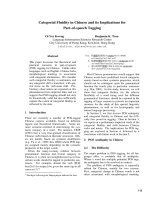ELECTRONIC SCIENTIFIC, TECHNICAL, AND MEDICAL JOURNAL PUBLISHING AND ITS IMPLICATIONS REPORT OF A SYMPOSIUM docx
Bạn đang xem bản rút gọn của tài liệu. Xem và tải ngay bản đầy đủ của tài liệu tại đây (3.72 MB, 122 trang )
ELECTRONIC SCIENTIFIC,
TECHNICAL, AND MEDICAL
JOURNAL PUBLISHING
AND
ITS IMPLICATIONS
REPORT OF A SYMPOSIUM
Committee on Electronic Scientific, Technical, and
Medical Journal Publishing
Committee on Science, Engineering, and Public Policy
Policy and Global Affairs Division
THE NATIONAL ACADEMIES PRESS
Washington, DC
www.nap.edu
THE NATIONAL ACADEMIES PRESS • 500 Fifth Street, NW • Washington, DC 20001
NOTICE: The project that is the subject of this report was approved by the Governing
Board of the National Research Council, whose members are drawn from the councils
of the National Academy of Sciences, the National Academy of Engineering, and the
Institute of Medicine. The members of the committee responsible for the report were
chosen for their special competences and with regard for appropriate balance.
Support for this project was provided by the National Academy of Sciences through an
unnumbered internal grant. Any opinions, findings, conclusions, or recommendations
expressed in this publication are those of the author(s) and symposium speakers and do
not necessarily reflect the views of the organizations or agencies that provided support
for the project.
International Standard Book Number 0-309-09161-6 (Book)
International Standard Book Number 0-309-53061-X (PDF)
Committee on Science, Engineering, and Public Policy, 500 Fifth Street, NW, Wash-
ington, DC 20001; 202-334-2424; Internet, />cosepup/
Additional copies of this report are available from the National Academies Press, 500
Fifth Street, NW, Lockbox 285, Washington, DC 20055; (800) 624-6242 or (202)
334-3313 (in the Washington metropolitan area); Internet,
Copyright 2004 by the National Academy of Sciences. All rights reserved.
Printed in the United States of America
The National Academy of Sciences is a private, nonprofit, self-perpetuating society of
distinguished scholars engaged in scientific and engineering research, dedicated to the
furtherance of science and technology and to their use for the general welfare. Upon the
authority of the charter granted to it by the Congress in 1863, the Academy has a
mandate that requires it to advise the federal government on scientific and technical
matters. Dr. Bruce M. Alberts is president of the National Academy of Sciences.
The National Academy of Engineering was established in 1964, under the charter of
the National Academy of Sciences, as a parallel organization of outstanding engineers. It
is autonomous in its administration and in the selection of its members, sharing with
the National Academy of Sciences the responsibility for advising the federal govern-
ment. The National Academy of Engineering also sponsors engineering programs aimed
at meeting national needs, encourages education and research, and recognizes the supe-
rior achievements of engineers. Dr. Wm. A. Wulf is president of the National Academy
of Engineering.
The Institute of Medicine was established in 1970 by the National Academy of Sci-
ences to secure the services of eminent members of appropriate professions in the ex-
amination of policy matters pertaining to the health of the public. The Institute acts
under the responsibility given to the National Academy of Sciences by its congressional
charter to be an adviser to the federal government and, upon its own initiative, to
identify issues of medical care, research, and education. Dr. Harvey V. Fineberg is presi-
dent of the Institute of Medicine.
The National Research Council was organized by the National Academy of Sciences
in 1916 to associate the broad community of science and technology with the Academy’s
purposes of furthering knowledge and advising the federal government. Functioning in
accordance with general policies determined by the Academy, the Council has become
the principal operating agency of both the National Academy of Sciences and the Na-
tional Academy of Engineering in providing services to the government, the public, and
the scientific and engineering communities. The Council is administered jointly by
both Academies and the Institute of Medicine. Dr. Bruce M. Alberts and Dr. Wm. A.
Wulf are chair and vice chair, respectively, of the National Research Council.
www.national-academies.org
STEERING COMMITTEE ON ELECTRONIC SCIENTIFIC,
TECHNICAL, AND MEDICAL JOURNAL PUBLISHING AND
ITS IMPLICATIONS
EDWARD H. SHORTLIFFE (Chair), Columbia University Medical
Center, Columbia University
DANIEL E. ATKINS, University of Michigan
FLOYD BLOOM, The Scripps Research Institute
JANE GINSBURG, Columbia University School of Law
CLIFFORD LYNCH, The Coalition for Networked Information
JEFFREY MACKIE-MASON, University of Michigan
ANN OKERSON, Yale University
MARY WALTHAM, Publishing Consultant
Principal Project Staff
Paul Uhlir, Project Director
Alan Inouye, Senior Program Officer
Julie Esanu, Program Officer
Robin Schoen, Program Officer
Kevin Rowan, Project Associate
Amy Franklin, Senior Program Assistant
COMMITTEE ON SCIENCE, ENGINEERING, AND PUBLIC
POLICY
MAXINE F. SINGER (Chair), Carnegie Institution of Washington
R. JAMES COOK, Washington State University
HAILE T. DEBAS, University of California, San Francisco
MARYE ANNE FOX, North Carolina State University
ELSA M. GARMIRE, Dartmouth College
MARY-CLAIRE KING, University of Washington
W. CARL LINEBERGER, University of Colorado
ANNE C. PETERSEN, W. K. Kellogg Foundation
CECIL B. PICKETT, Schering-Plough Research Institute
GERALD M. RUBIN, Howard Hughes Medical Institute
EDWARD H. SHORTLIFFE, Columbia University Medical Center,
Columbia University
HUGO F. SONNENSCHEIN, The University of Chicago
IRVING L. WEISSMAN, Stanford University, School of Medicine
SHEILA WIDNALL, Massachusetts Institute of Technology
MARY LOU ZOBACK, U.S. Geological Survey
Staff
Richard E. Bissell, Executive Director
Deborah D. Stine, Associate Director
Marion E. Ramsey, Administrative Associate
vii
Preface
The use of the Internet and other digital information technologies by
the scientific, technical, and medical (STM) research community in the
United States and most other countries has transformed many aspects of
the research and publishing process. The new technologies have created
fundamental changes in the production, management, dissemination, and
use of all types of information. It is now possible to communicate research
results much more quickly, broadly, and openly than was possible through
traditional print publications in the past. Researchers are now able to make
available independently their data and articles online, where the informa-
tion may be easily found, browsed, annotated, critiqued, downloaded, and
freely shared. This is resulting in significant changes to the linear path of
writing, refereeing, and reviewing of publications as all these functions can
be performed concurrently. Most STM publishers also now publish elec-
tronic versions of their journals, some exclusively so. The technological
developments and resulting changes to the sociology of science are creating
both opportunities and challenges for the effective management of scien-
tific communication generally, and STM publishing more specifically.
Because of the far-reaching implications of these developments, the
National Academy of Sciences Council’s Committee on Publications rec-
ommended that the Council commission a study of the factors involved in
the changing mechanisms for access to STM information in the scholarly
publications and the various technical, legal, policy, and economic issues
that they raise. The committee indicated that it is imperative for the Na-
tional Academies to address, in particular, the increasing concerns about the
viii PREFACE
implications of various models for access to STM publications for the scien-
tific community.
As a result, the Committee on Science, Engineering, and Public Policy
was asked to appoint a committee to oversee the planning for the Symposium
on Electronic Scientific, Technical, and Medical Journal Publishing and Its Im-
plications, which was held May 19-20, 2003, at the National Academy of
Sciences in Washington, D.C. The symposium brought together experts in
STM publishing, both producers and users of these publications, to: (1) iden-
tify the recent technical changes in publishing, and other factors, that influ-
ence the decisions of journal publishers to produce journals electronically; (2)
identify the needs of the scientific, engineering, and medical community as
users of journals, whether electronic or printed; (3) discuss the responses of
not-for-profit and commercial STM publishers and of other stakeholders in
the STM community to the opportunities and challenges posed by the shift
to electronic publishing; and (4) examine the spectrum of proposals that has
been put forth to respond to the needs of users as the publishing industry
shifts to electronic information production and dissemination.
The symposium was divided into six sessions, each introduced by open-
ing comments from a moderator, followed by several invited presentations.
Session 1 examined the costs involved with the publication of STM journals
while Session 2 looked at the related publication business models. Session 3
explored the legal issues in the production and dissemination of these jour-
nals. Sessions 4 and 5 looked toward the future and examined, respectively,
what is publication in the future and what constitutes a publication in the
digital environment. The final session provided several commentaries on the
presentations and discussions that took place during the symposium.
The proceedings of the symposium were taped and transcribed, and
served as the basis for this symposium report. The formal Proceedings of the
symposium are available online via the National Academies Press. The Na-
tional Academies hosted a live audio webcast of the symposium to reach a
broad audience and receive additional input. The webcast, along with the
edited Proceedings of the symposium, can be found on the symposium Web
site at />This report is based on excerpts from the symposium Proceedings that
the committee found particularly useful to highlight. It summarizes the views
of the symposium participants but does not contain any consensus findings,
conclusions, or recommendations of the committee itself. A footnote in each
major section of the report identifies the individuals responsible for the views
presented there. In addition, Chapters 3-7 each have a final section entitled “Is-
PREFACE ix
sues Raised in the Discussion” that summarizes portions of the general discussion
of the expert invited panel speakers among themselves and with the audience.
Because of the large number of speakers providing comments in those discus-
sions, we have not attributed each point to specific individuals. However, the
source of each point may be found in the edited online Proceedings.
The report does not cover all the issues that a more comprehensive
study might consider, since it is limited only to the topics discussed during
the symposium. Several important issues were identified in subsequent dis-
cussions, including: the relationship of journal size (number of “pages,”
articles, issues) to total annual cost; the “first copy” costs and the relation-
ship of those costs to income sources such as subscriptions or payments
from aggregators; and federal policies on the publication of articles in STM
journals by recipients of federal research support.
Nor was it possible to involve representatives of all types of STM jour-
nals or of all functions in the broader process of scientific communication.
The comments and suggestions made by the various participants cannot be
generalized easily across the entire spectrum of publications in the STM jour-
nal enterprise. For example, significant differences exist between for-profit
and not-for-profit journals, between those that represent professional societ-
ies and those that do not, between journals that derive revenues from adver-
tisements and those that do not, and between clinical and basic science jour-
nals. With regard to the latter, for instance, editors of clinical journals caution
that they have a special responsibility in quality control and review. Whereas
readers of basic science journals are generally scientists who can critique the
articles they read, those who turn to clinical journals for current knowledge
frequently may not be experts in the research disciplines covered and have
come to depend on the editorial process to assure the accuracy and validity of
the papers that they read. The quality and safety of patient care may thus be
tied rather directly to the quality of the editorial process in clinical journals.
Despite these acknowledged limitations of the symposium discussions
and the resulting report, the committee believes that the material presented
here will help identify specific areas for more in-depth inquiry by all the
stakeholders in STM journal publishing and in scientific communication
more generally.
Edward Shortliffe
Committee Chair
Paul Uhlir
Project Director
xi
The Committee on Electronic Scientific, Technical, and Medical Jour-
nal Publishing and Its Implications would like to thank the following indi-
viduals (in alphabetical order) who made presentations during the sympo-
sium (see Appendix A for the final symposium agenda): Hal Abelson,
Massachusetts Institute of Technology (MIT); Bruce Alberts, National
Academy of Sciences; Kent Anderson, New England Journal of Medicine;
Malcolm Beasley, Stanford University; Robert Bovenschulte, American
Chemical Society; Monica Bradford, Science; Patrick Brown, Stanford Uni-
versity; Brian Crawford, John Wiley & Sons; James Duderstadt, University
of Michigan; Joseph Esposito, SRI Consulting; Michael Jensen, Harvard
Business School; Michael Keller, HighWire Press; David Lipman, National
Center for Biotechnology Information; Wendy Lougee, University of Min-
nesota; Richard Luce, Los Alamos National Laboratory; James O’Donnell,
Georgetown University; Paul Resnick, University of Michigan; Bernard
Rous, Association for Computing Machinery; Alex Szalay, Johns Hopkins
University; Gordon Tibbitts, Blackwell Publishing USA; and Ann Wolpert,
MIT.
The committee also would like to express its gratitude to the guidance
group for this project, which was formed under the Committee on Science,
Engineering, and Public Policy. Members of that group included, James
Cook, Washington State University; Paul Torgerson, Virginia Polytechnic
Institute and State University (retired); and Edward Shortliffe, Columbia
University Medical Center, Columbia University.
Acknowledgments
xii ACKNOWLEDGMENTS
This volume has been reviewed in draft form by individuals chosen for
their diverse perspectives and technical expertise, in accordance with proce-
dures approved by the NRC’s Report Review Committee. The purpose of
this independent review is to provide candid and critical comments that
will assist the institution in making its published report as sound as possible
and to ensure that the report meets institutional standards for objectivity
and evidence. The review comments and draft manuscript remain confi-
dential to protect the integrity of the deliberative process.
We wish to thank the following individuals for their review of this
report: Martin Blume, American Psychological Society; Karen Hunter,
Elsevier Health Services; Justin Hughes, Cardozo Law School; James Neal,
Columbia University; Andrew Odylzko, University of Minnesota; and
Carol Tenopir, University of Tennessee at Knoxville.
Although the reviewers listed above have provided constructive com-
ments and suggestions, they were not asked to endorse the content of the
report, nor did they see the final draft before its release. The review of this
report was carried out in accordance with institutional procedures and all
review comments were carefully considered. Responsibility for the final
content of this report rests entirely with the authoring committee and the
institution.
Finally, the committee would like to recognize the contributions of the
following National Research Council staff. Paul Uhlir, director of the Of-
fice of International Scientific and Technical Information Programs, was
the project director for the symposium and principal editor of the
committee’s report; Julie Esanu, program officer for the Office of Interna-
tional Scientific and Technical Information Programs, helped organize the
symposium and edit the report; Alan Inouye, interim director of the Com-
puter Science and Telecommunications Board, and Robin Schoen, pro-
gram officer for the Board on Life Sciences, provided advice on the project;
Kevin Rowan, project associate for the Committee on Science, Engineer-
ing, and Public Policy, provided project support for the May symposium;
and Amy Franklin, senior program assistant for the Board on International
Scientific Organizations, assisted with the production of this report.
xiii
Contents
Executive Summary 1
1. Introduction 7
2. Costs of Publication 9
3. Publication Business Models and Revenue 20
4. Legal Issues in the Production, Dissemination, and Use of the 40
Journal Literature
5. What Is Publishing in the Future? 48
6. What Constitutes a Publication in the Digital Environment? 56
7. Symposium Wrap-Up 67
Appendixes
A Symposium Agenda 75
B Biographical Information for Speakers and Steering 80
Committee Members
C Symposium Participants 94
1
Executive Summary
The Symposium on Electronic Scientific, Technical, and Medical
(STM) Journals and Its Implications addressed these issues in five key areas.
The first two—costs of publication and publication business models and
revenue—focused on the STM publishing enterprise as it exists today and,
in particular, how it has evolved since the advent of electronic publishing.
This was followed by a review of copyright and licensing issues of concern
to the authors and to universities. The final two sessions looked toward the
future, specifically, at what publishing may be in the future and what con-
stitutes a publication in the digital environment.
COSTS OF PUBLICATION
The initial session identified the main elements of expenses (both print
and electronic) for many STM journal publications. It was quite clear from
the presentations that understanding all the cost elements in the budgets of
different publishers is not straightforward and that a comparative analysis,
in particular, would be very difficult to do well. At the same time, some
speakers indicated that such a study, if done carefully and authoritatively,
could be very useful in adding some rigor to the ongoing debate about the
high cost of journal subscriptions and the value that publishers bring to the
process of scientific communication.
Other cost-related issues that were discussed included the creation and
operation of digital archives and the digital conversion of back sets; the
2 ELECTRONIC PUBLISHING
costs of new technology and related cost-containment strategies and the
difficulty of moving from print to electronic-only versions; strengths and
weaknesses of the peer-review process; cost issues specific to small and mid-
sized societies; and the vulnerability of secondary and tertiary publishers.
PUBLICATION BUSINESS MODELS AND REVENUE
This, understandably, was the most contentious part of the sympo-
sium. A number of trends in commercial STM journal publishing were
described at the outset. These include the bundling of publications by ma-
jor publishers in “big deals”; the consolidation of publishers and the target-
ing of downstream competitors (secondary publishers and subscription
agencies) and of vulnerable competitors; diversification of the customer
base to more business clients (and a concomitant emphasis on applied re-
search and engineering journals); and market responses to open-access
trends, including the creation of meta-content (e.g., documentation and
search engines for the open-content resources) and a shift to Web services
(e.g., substitutes for the publication of fixed content in print by providing
online software, processing, and services for users).
This discussion of commercial publishing trends was followed by the
perspectives of a university librarian, a commercial journal publisher from
John Wiley & Sons, Inc., and an open-access representative from the Pub-
lic Library of Science (PLoS). The library overview included some statistics
and anecdotal information about the responses of libraries to rising sub-
scription costs and the bundling efforts of commercial publishers; the im-
plications for libraries of changes in electronic journal formats and content,
and of digital scientific communications more broadly; and the changing
role and influence of libraries in the digital publication context.
The description of the commercial subscription-based model used at
John Wiley & Sons highlighted the benefits to readers from this traditional
approach and the reasons why Wiley would not switch to the author-pays,
open-access model.
1
This was followed by the description of the PLoS
1
According to the definition presented by the Public Library of Science later in this
report, an open-access publication is one that meets two conditions. The first is that the
copyright holder (either the author or the publisher, if the copyright has been transferred to
the publisher) grants to the public a free, irrevocable, perpetual right of access to, and a
license to copy, distribute, perform, and display the work, and to make and distribute deriva-
EXECUTIVE SUMMARY 3
model, including the rationale for reconceptualizing the STM publishing
business model on the Internet, the definition of “open access” used by the
PLoS, and the advantages of this approach for science.
A vigorous and informative discussion ensued among the panelists and
with the audience about the relative merits of the traditional user-pays pub-
lishing model versus the author-pays PLoS model. Other related issues were
discussed, including the practical difficulties in transitioning to the open-
access publishing model, support of the open-access publishing approach
by research sponsors, the effect of different publishing business models on
the long-term preservation of digital journals, and advertising revenues in
electronic publishing generally.
The results of these discussions appeared to be inconclusive. On the
one hand, commercial (and professional society) publishers clearly add con-
siderable value to the process of formal scientific communication, and the
viability of the author-pays, PLoS type of open-access model is still un-
tested and its future success uncertain. On the other hand, the restricted,
subscription-based model clearly has great inherent social costs in compari-
son with the immediate, free access by any and all users of the information
worldwide that the open-access publishing model makes possible. Many
participants believed that we are in a period of important experimentation,
in which the open-access approach will be tested and refined and in which
the traditional publishers will try new approaches and attempt to add more
value to STM products and services. A greater differentiation between the
practices of commercial and society publishers also may be expected. For
example, there are hybrid approaches being implemented in the traditional
subscription-based publishing community, mostly by the not-for-profit
STM publishers. Moreover, there are other open-access approaches such as
self-archiving by authors and open institutional repositories, as discussed in
other sessions of the symposium.
tive works in any medium for any purpose. The second condition is providing readers with
open access to the work. Authors or publishers achieve open access by making a complete
version of the article and all supplemental materials available in some suitable standard elec-
tronic format, deposited immediately upon publication in at least one internationally recog-
nized, independent online repository that is committed to open access.
4 ELECTRONIC PUBLISHING
LEGAL ISSUES IN PRODUCTION, DISSEMINATION, AND USE
The focus in this session was on copyright and on licensing issues in
the traditional publishing business model. With regard to copyright, there
are divergent practices at universities as to whether the university or the
author owns the copyright to publications, and in the various derogations
from those rights. The question of transfer of copyrights from the author to
the publisher, and the limited rights granted back by the publisher to the
author, was discussed as well.
The licensing issues pertain to the terms and conditions that publish-
ers and libraries negotiate for site licenses, and to licenses between authors
and publishers. The libraries have continued to experience two significant
problems in negotiating site licenses, both related to the overall problem of
access restrictions: the various limitations and prohibitions on “interlibrary
loans” of electronic copies and the problem of long-term preservation of
material that is electronic-only under the restrictive licensing regime. Both
of these factors inhibit libraries from switching to electronic-only subscrip-
tions. As to the licenses between authors and publishers, two models were
suggested that serve the author’s interests better: either retain copyright,
while licensing the publisher to deploy the work in all ways that the pub-
lisher needs for effective publication and dissemination, or transfer copy-
right to the publisher, with more rights reserved to the author, such as
permission to redistribute the work.
Issues raised in the general discussion included a description of addi-
tional problems with the transfer of copyrights by authors in universities
(i.e., the author may not own the copyright under the university policy but
may not know that, thereby signing void copyright transfer agreements)
and significant problems associated with university work-for-hire ap-
proaches to academic publications. The burdens for small publishers in
developing countries from licensing practices and from restricting access
were also discussed.
WHAT IS PUBLISHING IN THE FUTURE?
The final two sessions of the symposium looked more toward the fu-
ture, by identifying some of the technology-enabled trends, processes, and
projects that are indicative of what may be possible and what may perhaps
become more widely adopted. As was noted in the introductory comments
for this session, it is quite clear that the digital revolution is changing the
EXECUTIVE SUMMARY 5
traditional processes of many knowledge-intensive activities, in particular
STM publishing and scholarly communication more generally. The vari-
ous functions—whether metadata creation, credentialing review, or long-
term stewardship—can be separated or disaggregated, and players different
from those who traditionally have carried out these tasks can, in theory,
perform them. Publications can now exist in many intermediate forms,
and we are moving toward more of a continuous-flow model, rather than a
discrete-batch model. The raw ingredients—the data, the computational
models, the outputs of instruments, the records of deliberation—can be
online and accessible by others and can be used to validate or reproduce
results at a deeper level than traditionally has been possible. Third par-
ties—particularly in an open-access, open-archives context—can then add
value by harvesting, mining, enriching, and linking selected content from
such collections.
The presentations in this session of the symposium identified some of
the social processes, specific pilot projects, and the challenges and opportu-
nities that may provide the basis for future “publishing processes,” which
ultimately may be more holistically integrated into the “knowledge cre-
ation process.” For example, there are emerging open recommender and
reputation systems that use the online environment to get broader public
feedback and to develop new indicators of user behavior. Although there
are potential problems, such as “gaming” the system, eliciting early evalua-
tions, and “herding,” whereby later evaluators are unduly influenced by
previous evaluators, there are some experiments that could be tried in the
STM publishing context. Preprint servers, such as the well-known e-Print
arXiv established initially for the high-energy physics community by Paul
Ginsparg at the Los Alamos National Laboratory, have now been adopted
by some other fields. Open institutional repositories, such as the MIT
OpenCourseWare project and the MIT-led DSpace consortium for the de-
posit of various types of research materials in an openly accessible archive,
provide additional examples of innovative projects and models.
Despite the exciting possibilities raised by these different initiatives, the
subsequent discussion raised a number of potential difficulties in implement-
ing some of these new approaches. Some of the issues raised included caution
about an over-reliance on statistical indicators or metrics in judging the qual-
ity of information or of publishing activities; the relative merits of the tradi-
tional, confidential peer-review process and a more open review system; the
constraints of the discrete-batch, print model on adopting some of the more
6 ELECTRONIC PUBLISHING
open, continuous-flow processes; and the inherent tensions between the cre-
ation of various open archives and the traditional publishers.
WHAT CONSTITUTES A PUBLICATION IN THE DIGITAL
ENVIRONMENT?
The final session built on the technology-oriented concepts and pro-
cesses introduced in the prior session. Publication used to refer to the act of
preparing and issuing a document for public distribution. It could also
refer to the act of bringing a document to the public’s attention. Now,
publication means much more. It can refer to a document that is Web-
enriched, with links, search capabilities, and potentially other services
nested in it. A publication now generates usage data and provides many
other functions. This session examined three innovative examples—the
Signal Transduction Knowledge Environment of Science, the publishing of
very large data sets in astronomy on Web sites and through the Interna-
tional Virtual Observatory initiative, and genomic data curation at the Na-
tional Center for Biotechnology Information and the integration of those
data with the scientific literature.
Issues raised in the discussion included the need for federal coordina-
tion and investment in the cyberinfrastructure to maximize the opportuni-
ties for information integration and knowledge creation, some of which
were identified in the final two sessions; the difficulties of quality control
and review of data in very large or complex databases, particularly in the
biological sciences; restrictions on data mining in proprietary STM infor-
mation that is based on publicly funded research; the opportunities for
knowledge discovery from the open publication of large and complex data
sets; the transformation of the archiving function in the knowledge discov-
ery process; lost opportunities associated with insufficient people and re-
sources focused on the avalanche of data in all disciplines; and the positive
role of the journal publishers in the successful development of databases in
molecular biology.
The main focus of this symposium was how different business and
distribution models for scientific, technical, and medical (STM) informa-
tion publishing are changing in the face of digital technology developments.
How do the emerging models address the need of the scientific communi-
ties for the widest possible long-term access to such information? In devel-
oping the symposium’s program, the planning committee was mindful of
the broad, ongoing changes in scientific research, funding, and goals—
changes that stimulate, and are stimulated by, new forms of scholarly com-
munication. The challenge was to identify issues and problems that the
STM communities need to control and resolve in order to exploit the re-
markable and growing opportunities offered by the rapidly evolving com-
puter and networking technologies.
Indeed, the current situation can perhaps be described as a “chaos of
concerns.”
1
The advances in digital technology are producing radical shifts
in our ability to reproduce, distribute, control, and publish information.
Yet, as these advances increasingly become an integral part of scientific
activity, they tend to conflict with some of the existing practices, policies,
and laws that govern traditional publishing.
1
Introduction
1
Portions of this Introduction are based on the keynote presentation by James
Duderstadt, president emeritus and University Professor of Science and Engineering Millen-
nium Project, University of Michigan.
7
8 ELECTRONIC PUBLISHING
The issues are complex, in part, because the stakeholders are so many,
so varied, and with different agendas. Those who fund research want to see
that the information is advanced and made available to the public. The
authors, reviewers, and part-time editors do not charge the publishers for
their labor. They are motivated to contribute to the public good and to
receive public recognition for their ideas, but of course they also have other
rewards, not the least of which is tenure. The journal publishers, as inter-
mediaries, while they do not pay for the material that they publish, do add
significant value, and provide the scholarly output in a useable, published
form. Libraries, similarly, provide an intermediary function by paying the
increasingly expensive subscription fees, though they typically do not charge
for subsequently providing access to the journals. And, of course, the end
users—who are also primarily the originators of the STM journal litera-
ture—either pay for their own personal subscriptions or obtain the resources
free through libraries.
All these stakeholders have their own needs and objectives in the evolv-
ing process of scholarly communication, many of which are congruent, but
some that now conflict, and all of which are being continually redefined by
technological, institutional, financial, and other changes. Current uncer-
tainties in the responsibilities for digital preservation and archiving func-
tions are but one example of this. The symposium therefore provided a
forum for identifying and discussing some of the key pressure points and
areas of disagreement by bringing together expert representatives of these
major stakeholder groups.
The symposium began with speakers in the first two sessions examin-
ing cost and revenue aspects of different business models in publishing
from the perspectives of some of the main types of stakeholders in the STM
publishing process. The third session provided a brief overview of legal
issues in the production, dissemination, and use of STM journals, focusing
on copyright and licensing by authors, universities, and publishers. Speakers
in the next two sessions then looked toward the future, speculating about
what publishing might be in the future and what constitutes publication in
the digital environment. The final session provided the perspectives of
several invited speakers on the symposium discussion. This summary high-
lights many of the key issues identified during the course of the proceed-
ings, in both the invited presentations and in the subsequent discussions
with the expert audience.
9
2
Costs of Publication
Electronic publishing has not only revolutionized the publishing in-
dustry, but it has also tremendously changed the fundamental economics
of the STM journal business. Many new issues affect both for-profit and
not-for-profit publishers. For publishers, the costs of journal production
appear to be increasing rapidly, much more than if publishers had stayed
with print alone. Two obvious factors are responsible for these rising costs:
the cost of new technology and the increasing volume of publishing. Thus,
it is natural to begin with a consideration of the costs of STM publishing.
MAIN ELEMENTS OF EXPENSE BUDGETS FOR SOME STM
JOURNAL PUBLICATIONS
1
Many STM journal publications have the same or similar cost compo-
nents. First are the processing costs for the contents (including articles,
1
This chapter is based on the remarks of Michael Keller, Ida M. Green University
Librarian at Stanford University and publisher of HighWire Press, who provided a keynote
“Overview of the Costs of Publication,” as well as on the comments of invited speakers—
Kent Anderson, publishing director at the New England Journal of Medicine; Robert
Bovenschulte, director, Publications Division, American Chemical Society; Bernard Rous,
deputy director and electronic publisher, Association for Computing Machinery; and Gor-
don Tibbits, president, Blackwell Publishing USA. Unlike the summaries of the subsequent
sessions, the comments made by several participants in the audience are incorporated into
the presentation material as well.
10 ELECTRONIC PUBLISHING
reports of research results, and methods of scholarly investigation) of STM
journals, in several subcategories:
2
(1) manuscript submission, tracking,
and refereeing operations; (2) editing and proofing the contents; (3) com-
position of pages; and (4) processing special graphics and color images.
Internet publishing and its capacity to easily deliver more images, more
color, and more moving or operating graphics have made this category of
expense grow rapidly in the past decade. The second category of expense is
not only a familiar one, but is also one of two targets for elimination from
publishers’ costs: This includes costs for paper, printing, and binding, as
well as mailing. A third category is the cost of Internet publishing services.
These are new costs and include many activities performed mainly by ma-
chines typically maintained by highly paid technical support staff, though
in some situations the publishing staff performs quality control pre- and
post-publication to check and fix errors that may have been introduced
into the publishing process. The elements of all the above costs vary tre-
mendously among publishers and Internet publishing services. The fourth
cost category—publishing support—includes items such as supporting fa-
cilities, marketing, and other miscellaneous expenses. The final category is
the cost of reserves.
The results of a recent sampling by Michael Keller of the changes in six
not-for-profit publishers’ costs over the past decade indicated several trends.
It appears the publishers now exercise much tighter controls over their bud-
gets than they did 10 years ago. Although the rate of change in editorial costs
has not changed much (e.g., costs continue to scale with the number of
submissions and inflation in salary and benefit costs), printing, paper, and
binding costs are down, at least on a unit basis. The new costs associated with
electronic versions of the same publications also can be significant.
In short, there is a dynamic balancing act with regard to publishers’
costs in the Internet era, with some costs increasing and some decreasing.
Most intriguing, however, is the possibility of removing substantial amounts
of publishing costs by switching to electronic-only journals delivered over
computer networks, thereby eliminating printing, binding, and mailing
paper copy to all subscribers.
2
The cost budgets for Science and Nature, for instance, would have more elements than
specified. And costs for secondary and tertiary publications include different elements than
these. These sorts of costs in STM publishing are not covered here.
COSTS OF PUBLICATION 11
DIGITAL ARCHIVES
Successful creation and operation of true digital archives—protected
repositories for the contents of journals—would permit the removal of the
printing, binding, and mailing costs. True digital archives will have their
standards and operational performances publicly known and monitored by
publishers, researchers, and librarians alike. The operations and content of
such archives will need to be audited regularly. The annual costs are not yet
well understood; they can range widely, from only tens of thousands of
dollars per year for a simple approach such as LOCKSS (Lots of Copies
Keep Stuff Safe), which are not formal archives,
3
to $1.5 million per year
for a large archive at a major university. Publishers, especially not-for-profit
publishers, feel a very strong obligation to preserve that digital heritage,
although there is no consensus about exactly who should do so: they them-
selves, libraries, some other third-party archivers, or some combination of
all of them.
CONVERSION OF BACK SETS
Another cost currently confronting many publishers is the conversion
of back sets of print journals to digital form, providing some level of
metadata and word indexing to the contents of each article, and posting
and providing access to the back sets. HighWire Press has done a review of
the costs of converting the back sets of its journals. They estimate that
about 20 million pages could be converted and that the costs of scanning
and converting pages to PDF, keying headers, loading data to the HighWire
servers, keying references, and linking references could approach $50 mil-
lion, or about $150,000 per title. Most of that sum is devoted to digitizing
companies and other sub-contractors of HighWire Press.
If all this retrospective conversion of back sets occurred in one year,
HighWire would have to spend internally about $250,000 in capital costs
and about $300,000 in initial staff costs, declining to annual staff expendi-
ture of perhaps $250,000 or $275,000 thereafter. On average, for the 120
publishers paying for services from HighWire that would mean about an
additional $2,500 in new operating costs to HighWire Press each year. In
other words, the increase in annual costs to publishers for hosting and pro-
3
See .

